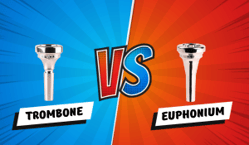Euphonium vs Trombone Mouthpieces: What's the big difference?


As a professional trombone and euphonium performer and college educator, I am asked about mouthpieces all of the time. A question that frequently is asked by trombone/euphonium doublers like myself is:
Can I use the same mouthpiece for both trombone and euphonium?
I usually answer with a sports analogy: You can play tennis with a squash racket, but that doesn’t mean you should! Unfortunately this works less and less since squash doesn’t seem as popular as when I was in college!
But, the moral of the story for me is, NO, you need to use the correct racket or “mouthpiece” for the correct job. A euphonium mouthpiece is different in many ways than a trombone mouthpiece, and here are the three most common:
1) Euphonium mouthpieces are larger in general than trombone mouthpieces.
2) Euphonium mouthpiece cup sizes are usually deeper and more conical in nature.
3) Euphonium mouthpiece shank sizes are different and have more options than trombone.
It is sometimes easy for young euphonium players to use a standard trombone mouthpiece for a few reasons:
1) Smaller trombone mouthpieces traditionally make higher register euphonium playing easier, which is what every young student wants.
2) Trombone mouthpieces are more readily available in music stores and band halls.
3) Knowledge! Unfortunately many students and teachers do not know that euphonium and trombone mouthpieces are different.
Get our newest tips, updates, videos, clinics, community events, and more by joining Denis Wick Tips Blog
Euphonium mouthpiece dimensions allow for an easier time producing a full, resonant, and beautifully rich sound. Control of the essential euphonium skill of vibrato is made easier with the design of the euphonium mouthpiece, as is pitch centering throughout all partials. Range comfort is also a plus and notes speak easier with clearer articulations. In short, a proper euphonium mouthpiece makes performing on the instrument easier and more fulfilling. Why wouldn’t you want that, especially when starting an instrument early on?
When doubling, make sure you look for a rim that provides a similar feel and comfort level, so that your switch is easier. That is why on trombone I use the Denis Wick Heritage series and on euphonium the Steven Mead Ultra X series. I find the switch is easier, especially in terms of rim comfort. Of course the cup size is different, but at least one constant stays in place that makes the switch easier. The earlier you can start young euphonium players on a proper mouthpiece, the sooner you will see upper level advancements in their performance abilities.
What I recommend: The Steven Mead euphonium series, including the Ultra and Ultra X options. Of course these mouthpieces provide all of the previously mentioned benefits including a rich and resonant sound, clear control of vibrato and pitch, and comfort throughout the entire range. In addition, I also love the clear articulation fronts that are produced on these mouthpieces.

Is your mute older than ours? Visit our Denis Wick Artist Group Oldest Mute Gallery to view our collection and submit an image of your own mute, or story of your favorite dent, to be added to our gallery.

Find all our Denis Wick resources in one spot on the Denis Wick app. Download to view videos, clinics, educator resources, podcasts, product information & more!



